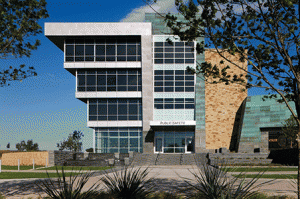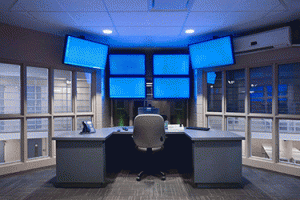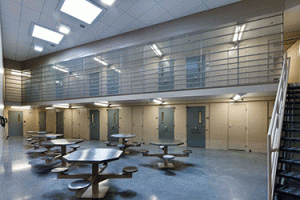Law enforcement, which is usually quick to employ new technologies in the field, has been slower to adopt the state of the art in their built environments. However, that’s changing, as both departments and architects specializing in public safety are taking a microscope to department facilities and seeking ways to make them function more efficiently and safely.
Public safety buildings are inherently complicated because of the functions they needs to provide for three distinct groups: law enforcement and support personnel, members of the general public, and detained individuals. How these groups interact and how different zones, rooms, and the equipment stored in them are secured are the most crucial aspects in planning a public safety facility, and one that is increasingly informed by sensitive design techniques and sophisticated technologies.
Form and Function
From the outside, a public safety facility requires two distinct faces—one inviting and one less so. The importance of projecting a welcoming face to the community can’t be underestimated; it’s as important as the need for limited visibility in and out of the detention portion. If handled deftly, the building exterior can project strength and solidity while simultaneously showing a certain kind of openness. This can be seen in the Grand Prairie, Texas, Public Safety Facility’s glassed public side, with stacked, cantilevered floors extending outward in a sturdy gesture of welcome. The use of green and silver copper panels brings texture and depth, especially to the lower-height, solid form of the jail.
 |
 |
 |
| Front | Atrium | Secure side |
|
All Photos © Charles Davis Smith, courtesy of Brinkley Sargent Wiginton Architects |
||
Ideally, visitors from the community park their vehicles and approach the building out of sight of the entry to the jail, with similar separation from staff and services entrances. Security in the form of bollards, fences, and parking lots secured with access control gates is in evidence beginning at the site perimeter, but these can be designed to blend in with the surroundings. Public safety buildings’ public faces extend to the surrounding communities, and there is a value both in fitting into the surroundings and in projecting strength and security.
Outside, the entry to the jail can be located around the corner (as it is at Grand Prairie’s facility), but inside the facility, staff and detainees eventually must converge. Throughout the interior, understanding necessary adjacencies and prioritizing access for certain groups becomes the key to visualizing the resulting facility.

| Lobby |
It is helpful to begin with members of the general public, since their activity in the facility will be the most limited. Mindful of this, the Grand Prairie facility places public-oriented spaces—chiefly, a community room and records department—on the second floor, directly above the entry lobby. The records department is designed to enable interaction between records staff and law enforcement, as well as between records staff and community members on different sides of the records department.
From the vertex of that small public footprint, the facility flows in two directions roughly in the shape of an L, with administrative functions located within the long axis and detention functions in the building core behind the lobby and within the building’s shorter axis. Similar to the public area, accommodating necessary adjacencies (booking, fingerprinting, interviewing, search rooms, and holding cells) drives the larger arrangement of spaces. Circulation zones are particularly tricky, given the simultaneous necessity of visibility (for reasons of security) and staff interaction with detainees of different genders and ages (of which Texas statutes demand visual and sound separation). This requires, first, separation of juveniles from adults, and then males from females, after which a deft design solution is to use the control point as a natural buffer. One-way polarizing film installed on the glass on both sides of the control area allows supervision of all areas by staff, but prevents visibility from one holding area to another.
 |
 |
| Jail Control | Jail Dayroom |
Another challenge is ensuring that circulation operates effectively for all levels of staff—law enforcement personnel (whether moving through the facility with detainees or alone), as well as employees who handle jail support functions such as laundry, food preparation, supplies and receiving, and so on. In some ways, detention areas need to function like a hotel, with front- and back-of-the-house circulation and access, with the added complication of areas that range from minimum to maximum security. The equivalent of the hotel service elevator is an elevator used purely for the movement of prisoners, which runs from the detention area up to the investigations unit’s fourth-floor interview suite. In the public safety domain, design has to sensibly accommodate holding areas and search rooms (for the examination of detainees and the removal of any property not already placed into custody) along the same corridor that accounts for janitorial services and linens.
A similar logic rules adjacencies in the much larger administrative portion of public safety facilities. Often, the planning of a facility sets off a free-for-all in which each group sees itself as needing the most ready access to traditionally first-floor or perimeter spaces such as parking, the detention area, or evidence room. For example, even fire safety personnel will make the case for primary access to the outdoors, even though an administration suite is not a firehouse.
In a small facility, there is a certain logic to detectives having direct access to detainees, but large facilities have too many masters and, likely, too many floors. With the need for property and evidence, crime scene, juvenile booking, and other such functions to be located centrally, and sally ports and intake requirements eating up ground floor square footage, it is inevitable that various departments will have to be moved out or up. In Grand Prairie’s 149,000-square-foot facility, patrol officers inhabit the second floor for reasons of quick access to the outside, but also to the second-floor records department; police and fire administrative areas, shared locker rooms, and other staff support spaces occupy the third floor; and the investigations unit takes up the fourth floor.
Equipped for Security
Gates, sally ports, card readers, cameras—the basic trappings of building security are second nature for public safety officers. But the state of the art in security measures is becoming almost exponentially sophisticated, and departments need to keep abreast of each advancement.
For example, the future promises to involve more integrated measures that help secure arms, equipment, and evidence. The architects of the Grand Prairie facility, Brinkley Sargent Wiginton, helped the agency move in this direction by specifying storage lockers in the evidence department equipped with an electronic tracking system. As officers, evidence technicians, and lab technicians drop off and process articles that are stored one to a locker, the resulting electronic trail of who has accessed each locker helps the department maintain control of sensitive items.
These systems, which are becoming more prevalent since their introduction just a few years ago, can be adapted to secure the storage and permit the card-activated removal of sidearms, Tasers, mobile computers, and radios utilizing bar codes or the even more sophisticated RFID chips. The costs of secured-release gun racks in particular remain high, which is hindering their wider use in weapon control.
Securing areas where officers and detainees share space has an obvious physical component—secure the prisoner, secure weapons, secure objects that could be used as weapons—but also a visual component. Some departments secure both table and chairs in interview rooms, ensuring both that furniture can’t be wielded or thrown and that those monitoring interviews get a clear picture on camera. Brinkley Sargent Wiginton’s designers think in terms of future litigation by providing for cameras placed high (forward view) and low (side view), thus ensuring the failure of detainees’ claims of police coercion (e.g., the alleged gun under the table).
Security—or, rather, concern over its absence—is at the heart of whether the sharing of video feeds by neighboring departments will become more prevalent. The possibility of such cooperation that allows the interview of a suspect—who is a person of interest in another jurisdiction can be seen in real time by investigators who can then open new areas of inquiry—has tremendous appeal in law enforcement, assuming there is confidence that both departments’ networks are secure.
Safety First
Public safety buildings involve many heavily scrutinized aspects of planning and design, from aesthetics to expandability to vehicular accessibility. One would be hard-pressed to find an aspect as important as control, be it control of the site, building, rooms, corridors, equipment, or people. Creating a facility that functions well and safely for the building’s operators and visitors requires both architects and officers to develop a mind-set of control and then carry this focus on security through to every corner of the eventual building plan. ♦
Please cite as
Steve Dye and Greg Read, “Mission: Control—The Design of an Efficient and Safe Public Safety Facility,” The Police Chief 82 (July 2015): web-only.


